Are collector cars works of art?
The 1979 BMW M1 painted by Andy Warhol is undisputedly a work of art. Yet knowledgable car enthusiasts might wonder if the M1 wasn’t one already. After all, it was supercar penned by Giorgetto Giugiaro, one of the most influential car designers of all time and, it’s worth adding, an artist from a long line of them (his grandfather painted church frescos). The question of whether a classic car can be art may seem an idle one, yet there’s a lot more riding on it than that. Consider that a concours condition M1 is worth somewhere in the neighborhood of $600,000, whereas the one with Warhol’s brushstrokes is widely thought to be worth tens of millions.
Indeed, for the relatively young market for collector cars, the art market is something like an older sibling. However, as the car market matures—by some measures it is more than 50 years old—it begins to draw some parallels with the much older art market. Does the evolution of the art market illustrate how the car market will evolve in the years and decades to come? The similarities and differences between them may provide an answer.
From Antwerp to online auctions
Although auctions have existed since ancient Rome, and as long as there has been fine art there have been connoisseurs and collectors, it wasn’t until much later that a widespread market in Europe began to take shape. Patronage from the Catholic church and families like the Medicis produced some of history’s most significant works, but the thing about the Sistine Chapel ceiling is that it isn’t exactly portable. A public marketplace like we might recognize today draws its roots to 15th century Antwerp and the Northern Renaissance. A burgeoning middle class and merchant trade business drove demand for paintings and prints depicting everyday subjects, many of which were smaller and more easily traded than large sculptures or tapestries. Guilds and art dealers vied for power over prices and distribution, and in the 18th and 19th centuries art auctions rose to prominence on the world stage. You know some of the big names: Sotheby’s (established 1744), Christie’s (1766), and Bonhams (1793).
Total auction sales suggest the art market is not only much older than that for cars but is also vastly bigger at a reported $10.1 billion in 2020, according to the Artnet News Intelligence Report. By comparison, classic car auctions earned approximately $1.4 billion in the same period.
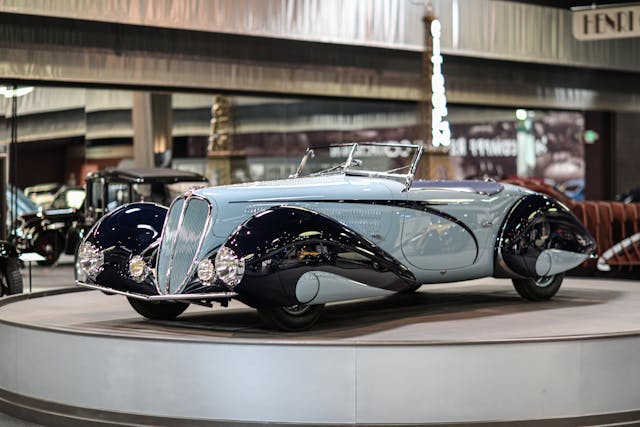
Yet auctions, as we’ve noted before, account for only a slice of classic car sales—maybe 10 percent—whereas for art they’re about half. Combining both segments of the respective markets, the picture flips: The car market has some $20 billion in annual sales, versus some $20.2 billion for art.
The car and art auction market carry different weights in their respective markets and likely play different roles, too. Whereas in the car market, auctions may be seen as a way to discover the price of a vehicle, in reality this may only be true for some segments. The very best vehicles often trade privately and when one similar example does sell at auction, the price merely reflects what has already occurred in the private market. The art auction market, representing a larger share of all sales, plays more of a leading role setting the tone of the market.
Both markets deal with considerations such as condition and provenance of the work of art or the vehicle; however as pieces of art are often unique (excluding prints), comparing the sales of different pieces of art over time is challenging. As vehicles often number in tens, hundred, or thousands of very similar examples, measuring the change in prices over time for a particular make or model is much more straightforward. Some vehicles trade so often at auction, and are so numerous and homogenous, it is possible to construct a repeat sale index of those sales.
Today, auction companies in both realms are experimenting with an increasing focus on online auctions. In the pandemic-ridden first half of 2020, sales of art via internet auctions increased nearly 475 percent, to $186.4 million; in the collector car world, online sales jumped 75 percent in the same period and grew even more through the summer. And of course, let’s not forget that in many cases, art and car auction houses now often operate as one, with the likes of Bonhams, Sotheby’s, and Artcurial pitching tents at major auto events.
Paul Russell SLs, Gagosian sharks
The private sides of the car and art worlds also look relatively similar from afar. Certainly, galleries in the art market have a similar counterpart in the car world: dealers. Dealerships with rows of shiny metal neatly arranged on equally shiny floors can be found all over the world. In the art market, galleries often represent living artists and act as a gatekeeper between the artist and collectors. Galleries often expect the collectors to refrain from flipping new works for a profit or else face being cut off from the opportunity to buy further works. Does the car market possess any such similar mechanism for managing supply and demand? Of course! The most in-demand automakers often have waitlists, favored collectors, and rules against flipping the hottest new models. Added dealer markups on the sticker price are another way the market reaches an equilibrium.
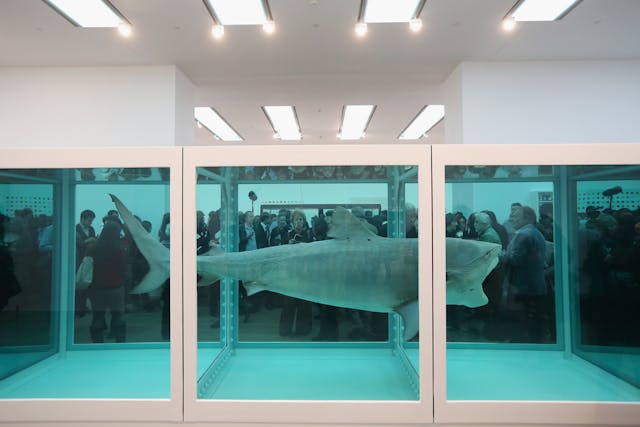
Yet car dealers can only dream of matching the influence of their peers in the art world. Although certain dealers specialize in particular marques and have a reputation among those in the know—say, Paul Russell’s association with the 300 SL—this dynamic is considerably more stark in the art world. Elite galleries like Gagosian, titanic brand names in their own right, wield enormous power in contemporary art spheres, anointing artists so their star might rise and in turn shaping tastes and trends. No vintage car dealer today can claim that kind of power. Remember, this is a world where a dead, stuffed shark can sell for $12M and many critics nod their heads in knowing approval. That’s not hyperbole, either. Gagosian famously sold one such Damien Hirst for that much in 2005. (The buyer eventually faced a Great White of a conundrum when the wretched thing began to rot in its tank.)
You say Old Masters, I say Prewar
Just as the car market is really a constellation of smaller segments, so too does the art market fall into many categories. These categories span centuries, versus a measly 150 years or so for cars, yet a car enthusiast can easily spot the similarities. In the table below are the six major categories of the art and car market. The years in the parenthesis represent when an artist in that category was born or when the vehicle was produced.
Both markets typically value the second chronological period highest, but in 2020 there were some exceptional prewar cars that sold at auction. Prewar Bugattis actually represent the top five sales at auction last year. In more routine years, a 1950s or 1960s Ferrari, Aston Martin, or Porsche would likely hold the top slot. The car market also mirrors the art market in the growth in sales of newer work.
Impermanent collections
Events
The differences in the values of the similar categories in the art and car markets can be partly explained by the collectors and what they do with their collections. Although the car world has numerous private collections with hundreds of vehicles, much as the art world does, the number of art museums in the U.S. is approaching 1600, which vastly outnumber the 100 or so car museums in the country. Those art museums can retain works of art in perpetuity, and risk public outcry when selling works for reasons other than funding collection acquisitions. In contrast, car museums tend to have more precarious funding, and sale of prominent vehicles into private collections is depressingly common. That affects the demand calculus of what people are willing to pay for scarce works of art when compared to similarly scarce automobiles.

Although the transience of vehicles hurts their values relative to art, the very fact that they can move is their biggest advantage. A collector car, simply put, is a car, which means its owner can engage with it ways that simply aren’t possible when it comes to most artwork. That’s not to say art can’t be appreciated in multiple ways: Art museums work with collectors to hold exhibitions; top-flight art fairs like those held in Basel, Switzerland, offer wealthy art collectors a social outlet much as Monterey Car Week does for deep-pocketed car enthusiasts. But car collectors have vintage races, rallies, tours, cars and coffees, and concours, not to mention the option to take their pride and joy to the beach on a sunny day.
Fundamental to this reality is that cars are industrial objects. Although a handmade Ferrari is a long way off from the comparatively throwaway Chevy Bel Air, the nature of the machine is such that cars are closer to precise craft work than fine art. It’s in this manner that modern art museums like MoMA and the Guggenheim have recognized particular cars like the VW Beetle—for their influential design—the same way such institutions might immortalize the Bakelite rotary telephone for future generations to admire.

An important outlier that recently came to market are the three Alfa Romeo B.A.T. cars, sold by Sotheby’s in October 2020 for $14.84M. This trio, or “triptych” as they were aptly dubbed, of handmade, functional 1950s concept cars sold at the auction house’s Contemporary Art Evening Auction—a fine art sale that ordinarily does not include vehicles. Why the exception? “The B.A.T. cars are possibly the best examples of cars as works of art,” says Nick Cinque, vice president and director of private sales at Sotheby’s. “They truly exude a sculptural elegance. Each car is a one-of-one with a unique artistic vision, which is more akin to traditional art than cars, where the majority are mass produced and can be owned by a vast number of people rather than one collector.”
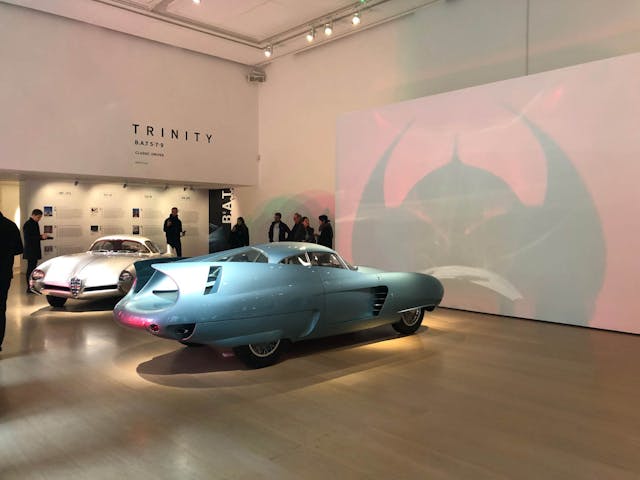
Rarity, provenance, uniqueness of artistic vision—these are all measurements by which the art market has long regulated what is valuable. That these measurements all factor into car values is not mere coincidence. Neither is the fact that top-tier car collectors increasingly prize originality and preservation over restoration. Like it or not, the subjective tastes of the art world play into what car enthusiasts like and are willing to pay for.
What separates cars from art, in many ways, is their functionality and performance. That a Mustang Mach 1 is more rare than a convertible six-cylinder with a three-speed auto is one thing, but the fact that the Mach 1 can dust the ordinary pony from a stoplight and carve circles around it on a road course is something definitive, something concrete and quantifiable. And it’s why a successful motorsport pedigree carries so much weight in our world. Winning races is incontrovertible proof of prowess.
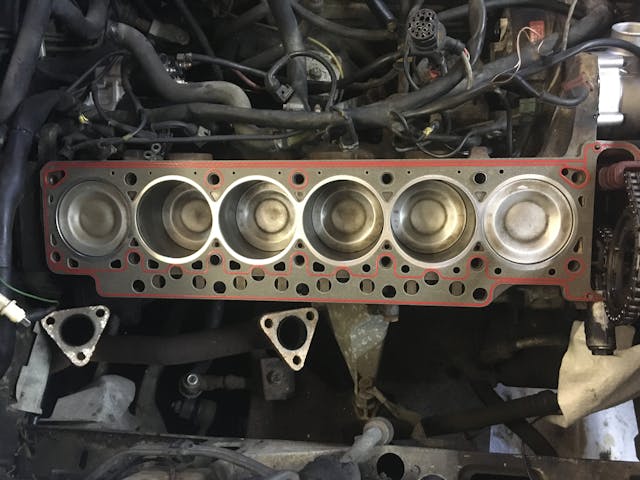
Naturally, cars come with their own caveats. Storage, transport, and upkeep for cars and art are very different propositions. Whereas art is perfectly content to be tucked away in a climate-controlled room, cars need to be regularly exercised to remain in working order. Even outdoor sculptures exposed to the elements may only require annual cleanings, while vehicle maintenance for specialized models can be considerably more involved. Of course, the tinkering and detailing also represent ways in which car enthusiasts engage with their objects of desire.
For love and for money
Many of us are involved in classic cars because we love them. Others see cars as an investment opportunity. Writ large, art buffs are no different, in that the long-term, serious collectors tend to buy what they like rather than what’s trending up and can be flipped for a profit. It’s all fair game, but even the most savvy collectors in either field would rather share their home with a meaningful pursuit than a stock share that hangs on the wall or sits in the garage.
Where does the car market go from here? Does it continue to follow the art market? While there will likely continue to be some convergence, given the differences in the collectors and the nature of the assets, the two will likely remain distinct. We should strive to keep it that way, too. Compared to the enormity of the art world, ours is a niche sector whose predilections are still somewhat distinct from the general public. The unenlightened may raise their brows approvingly at someone’s acquisition of a Warhol print only to then roll their eyes at the vintage Aston Martin in the driveway. And really, we shouldn’t mind when this happens from time to time. More for us, right?
This story originally appeared on Hagerty Insider.
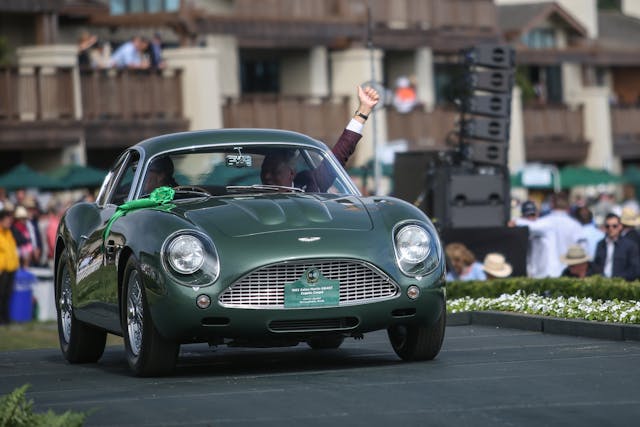
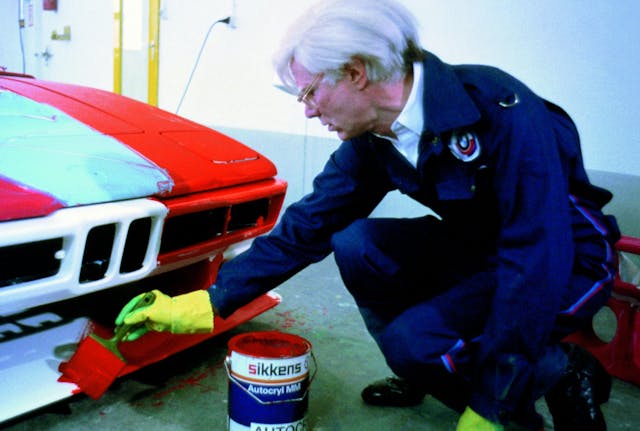


This is an interesting article. As a Contemporary Artist and a classic car owner I believe there is a correlation between them as you indicate. I’ve often wondered if car collectors also collect art with car themes. Thank you for publishing this.